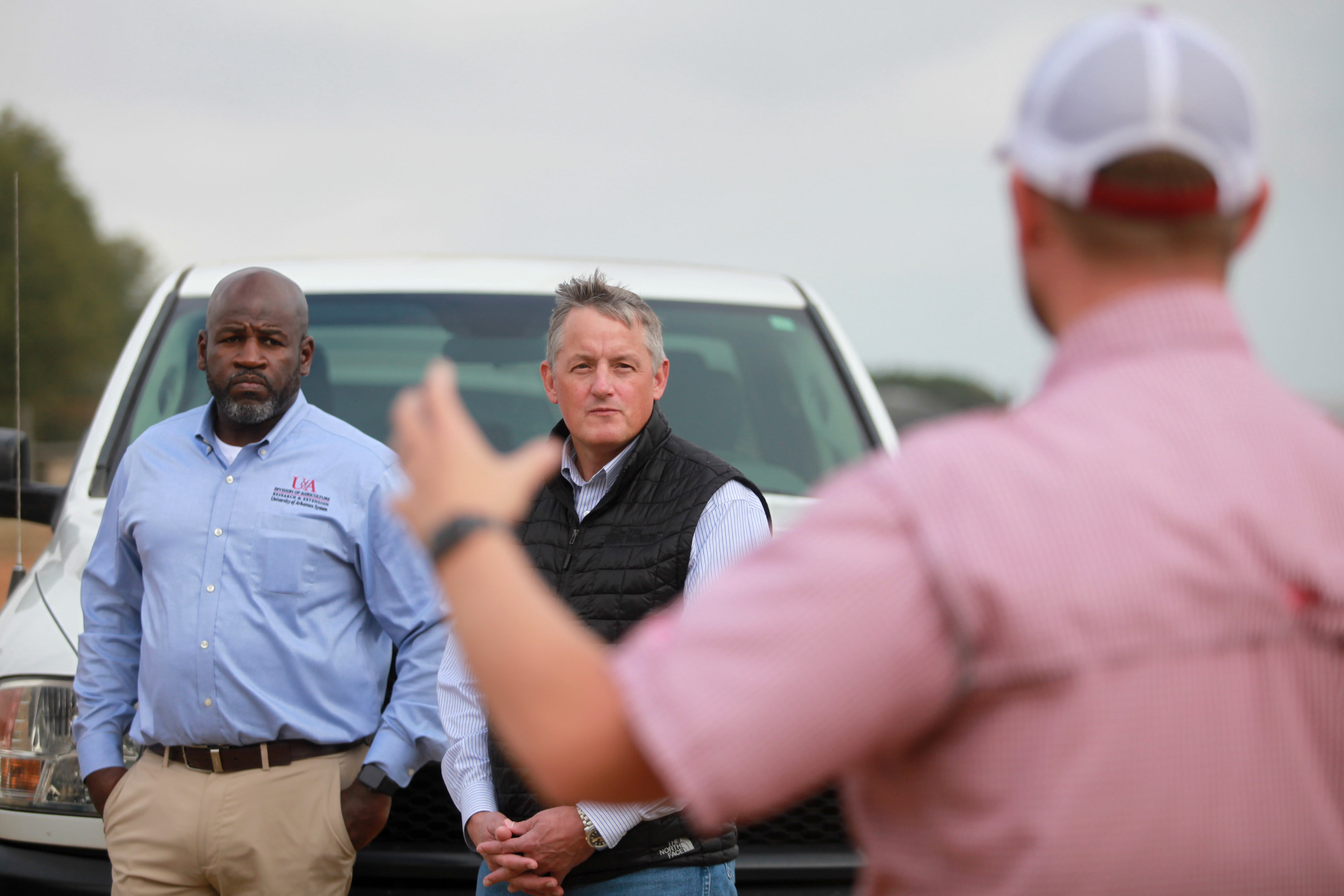Westerman tours Southwest Research and Extension Center during agriculture tour
Oct. 21, 2022
By Ryan McGeeney
U of A System Division of Agriculture
Fast Facts:
- Westerman represents Arkansas’ Fourth Congressional District
- Serves on the Natural Resources Committee
- SWREC conducts ongoing research in many areas of agriculture, including cattle and forage, horticultural pest management
(469 words)
(Newsrooms: With additional art at https://flic.kr/s/aHBqjAaZSv)
HOPE, Ark. — From the global economy and supply chain to the global climate and regional weather patterns, perhaps no industry is as affected by external forces as agriculture. For better or worse, that makes farming a primary concern of political representatives at every level — especially in a state dominated by agriculture.
U.S. Congressman Bruce Westerman, who represents Arkansas’ fourth district, visited the Southwest Research and Extension Center last week. Westerman said he typically takes time during each Congressional recess to meet with farmers, agricultural researchers and other industry professionals throughout Arkansas.
“We do have the farm bill coming up next year,” he said. “Tours like this give me a chance to get input from farmers and other people who will be impacted by that bill.”
Daniel Rivera, associate professor for the University of Arkansas System Division of Agriculture and director of the research center, said he was glad to have the opportunity to show off the SWREC’s cattle and grazing facilities, demonstrating how the research is key to the success of many Arkansas producers.
“We’re talking about some of the things we’re doing to navigate the drought,” Rivera said. “We’ve implemented a management program where we’ve been able to fertilize grasses in August and take advantage of some of those timely rains. That allowed us to get some grass growing and stockpile it.”
Rivera spoke about how various systems, such as the “300 Days of Grazing” concept, work to both ensure adequate feed for cattle and help to naturally clear biomass from fields, making it easier and less input-intensive to plant cold season grasses.
“There’s really no way to move forward other than with tighter management,” he said. “What we’re trying to show is that if you adhere to these principals, we can take advantage of that grass, without having to feed any hay.”
The center, part of the Division of Agriculture’s network of research stations across the state, focuses on several areas in addition to forage and grazing, including horticulture propagation and pest management. It also houses the state’s nematode laboratory, which analyzes soil samples for pests.
Amanda Greer, nematode lab supervisor, told Westerman about the lab’s importance to agricultural exports.
“We get samples of pine shavings from loads that go to China, for example,” Greer said. “We look to make sure there aren’t pests in the samples, and report back. That way, they can be issued a permit.”
Greer said the lab analyzes samples from growers throughout the state, as well as the Arkansas Plant Board and other states’ respective plant boards.
A native of Hot Springs, Westerman was first elected to the U.S. House of Representatives in 2014. Among other assignments, he serves on the House Committee on Natural Resources. Before his election to national office, he served two terms in the Arkansas General Assembly.
To learn about extension programs in Arkansas, contact your local Cooperative Extension Service agent or visit www.uaex.uada.edu. Follow us on Twitter and Instagram at @AR_Extension. To learn more about Division of Agriculture research, visit the Arkansas Agricultural Experiment Station website: https://aaes.uada.edu/. Follow on Twitter at @ArkAgResearch. To learn more about the Division of Agriculture, visit https://uada.edu/. Follow us on Twitter at @AgInArk.
About the Division of Agriculture
The University of Arkansas System Division of Agriculture’s mission is to strengthen agriculture, communities, and families by connecting trusted research to the adoption of best practices. Through the Agricultural Experiment Station and the Cooperative Extension Service, the Division of Agriculture conducts research and extension work within the nation’s historic land grant education system.
The Division of Agriculture is one of 20 entities within the University of Arkansas System. It has offices in all 75 counties in Arkansas and faculty on five system campuses.
Pursuant to 7 CFR § 15.3, the University of Arkansas System Division of Agriculture offers all its Extension and Research programs and services (including employment) without regard to race, color, sex, national origin, religion, age, disability, marital or veteran status, genetic information, sexual preference, pregnancy or any other legally protected status, and is an equal opportunity institution.
# # #
Media Contact:
Ryan McGeeney
rmcgeeney@uada.edu
@Ryan_McG44
501-671-2120
